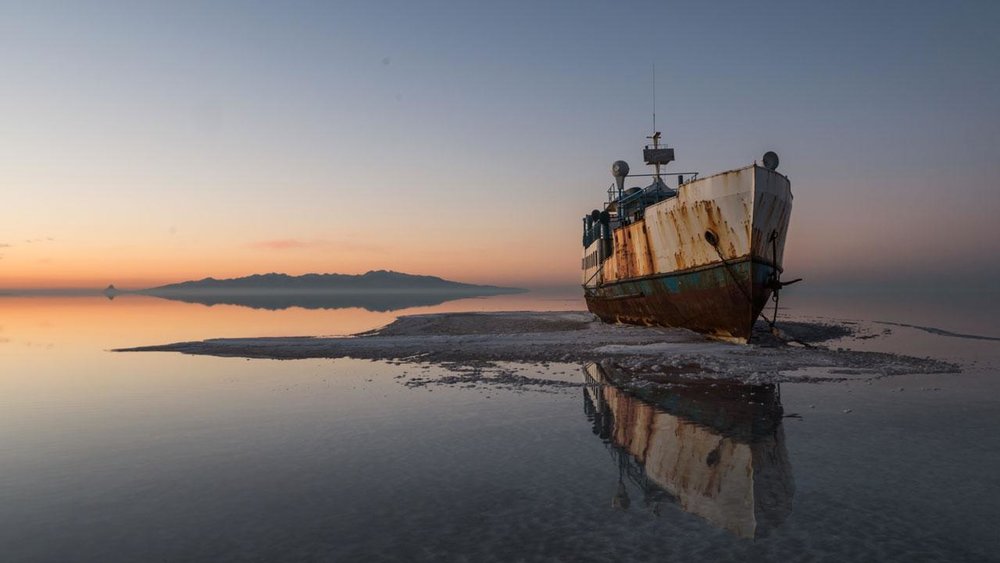Budget deficiency is holding back Lake Urmia complete restoration

TEHRAN —Lake Urmia, once called a symbol of Azari identity, dubbing it “the turquoise solitaire of Azerbaijan”, is on the road to ruin and the officials blame it on budget constraint.
Lake Urmia, in north-western Iran, was twice as large as Luxembourg and the largest salt-water lake in the Middle East. In 1997 the volume of water at the lake measured at 30 billion cubic meters which dramatically decreased to half a billion cubic meters in 2013 and again rose to 2.5 billion cubic meters in 2017. While the lake had a surface area of 5,000 square kilometers in 1997 the surface shrunk to one tenth of that to 500 square kilometers in 2013.
In an exclusive interview with the Tehran Times, Masoud Tajrishi, an official with Lake Urmia restoration program and the current deputy chief environment, explained the main reasons for lake’s unprogressive restoration process.
Lake Urmia is now stretching over 1,700 square kilometers of land area but the surface area is expected to increase to 4,300 square kilometers, Tajrishi said.
The volume of water at the lake is now estimated at one billion cubic meters which is short of last year’s volume by 400 million cubic meters, he added.
The numbers seem to indicate a decrease in the volume of the water compared to last year (2016) but by comparing the figures to a year before that (2015) the lake is experiencing an increase both in the surface area and volume of the water by 300 square kilometers and 200 million cubic meters respectively, Tajrishi noted.
As per a law adopted by the government, Lake Urmia restoration program was supposed to attempt to stabilize the lake water level within three years, he said.
Looking into the lake depletion process over the 20 years before implementing the lake restoration program (2013) water level has dwindled away by 40 centimeters per annum, Tajrishi said, adding, in other words over the 20-year period the lake water level diminished by 8 meters, almost equal to a three-story building.
Experts believed that continued degradation of the lake would lead to its total dryness, he said. Desiccation would increase the frequency of salt storms that sweep across the exposed lakebed and negatively affect lives of 14 million people indirectly. Moreover, it diminishes the productivity of surrounding agricultural lands and encourages farmers to move away. Poor air, land, and water quality all have serious health effects including respiratory and eye diseases for some 6 to 7 million people residing the lake basin.
“So despite the reduction in prescription last year, the measures we took helped stabilize the lake condition,” he noted, adding, so instead of 120 centimeters drop in the lake water level over the a three-year period we helped to improve the lake condition. “The water level might fluctuate from time to time but in general this is a characteristic of floodplain wetlands,” he stated.
Speaking on the effectiveness of dredging to help the wetland revive Tajrishi said that dredging allows for an increased flow of water through wetlands “so last year we managed to allow 1.9 billion cubic meters of water to flow into the lake.”
We also prevented farmers to pump water to their agricultural lands in season other than cropping season, he said.
Another measure taken by the lake restoration program to protect the lake from draining away was to task Ministry of Energy to reduce the amount of water flow from the dams annually by 8 percent and allocate the amount to the lake to help restore it, he suggested. Right now, after three years, some 24 percent of the water right of the lake is enforced.
Such remedial actions help safeguard the lake and stabilize its condition for now, but in order to implement the complementary schemes we need to raise fund and get the lake annual budget, he said, regretting, last year instead of the pledged 12 billion rials (nearly $300,000) budget we only got 3 billion rials (nearly $75,000).
“If the administration allots the lake annual budget we will be able to expand our activities by offering the farmers technical supports to prevent lake dryness and provide the lake with its water right, otherwise 60 percent of the lake water will dry,” he warned.
“We are no planning on limiting agriculture in the area, we are after modern agriculture,” he restated.
MQ/MG
Leave a Comment